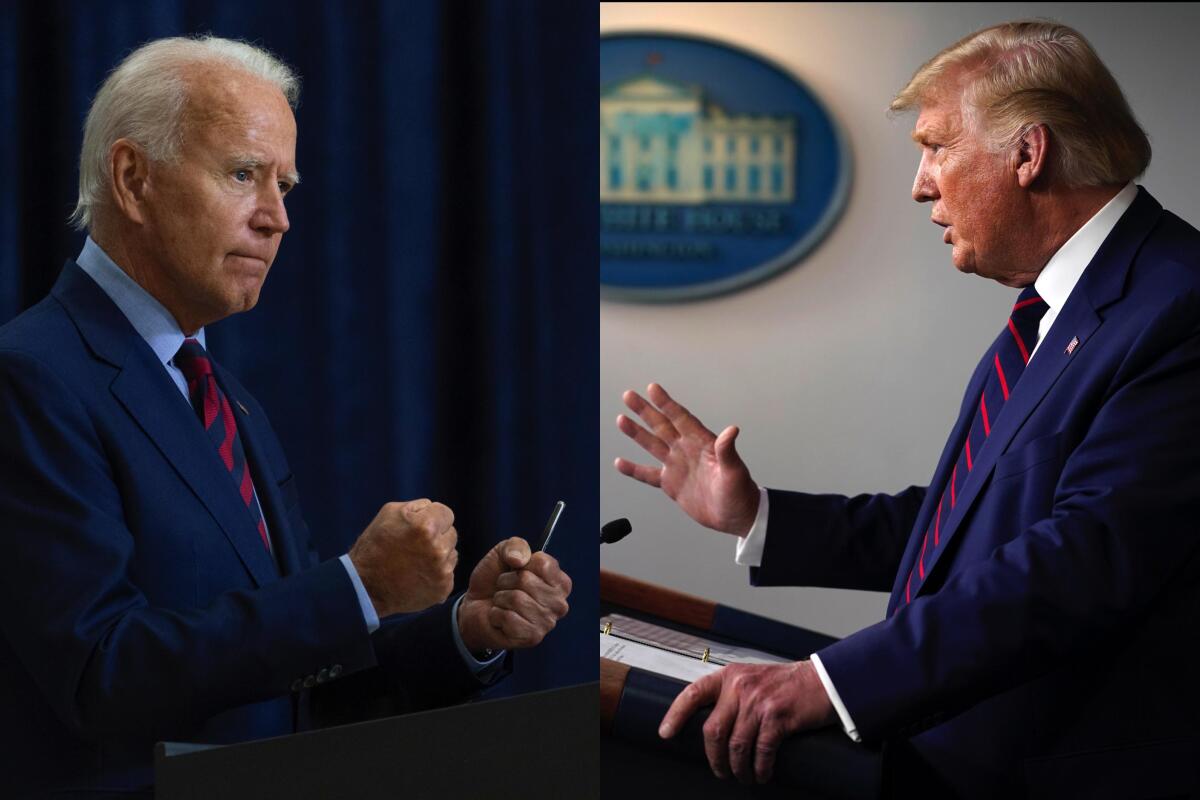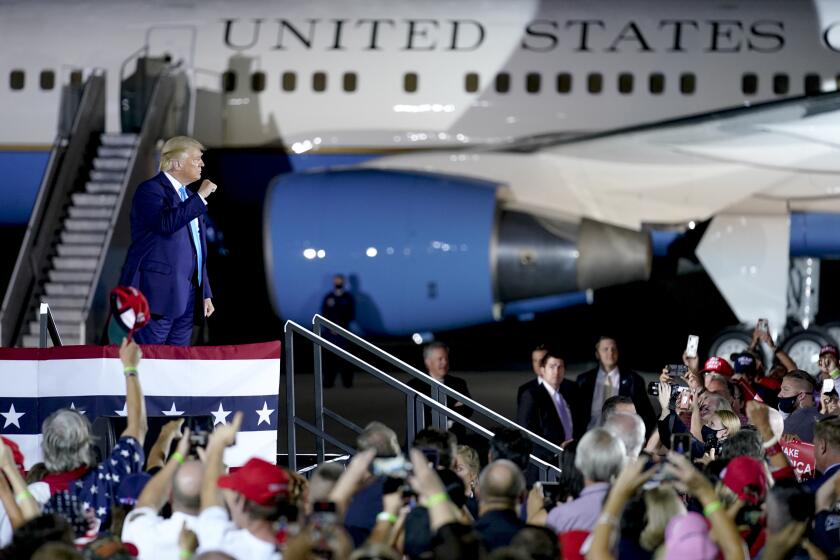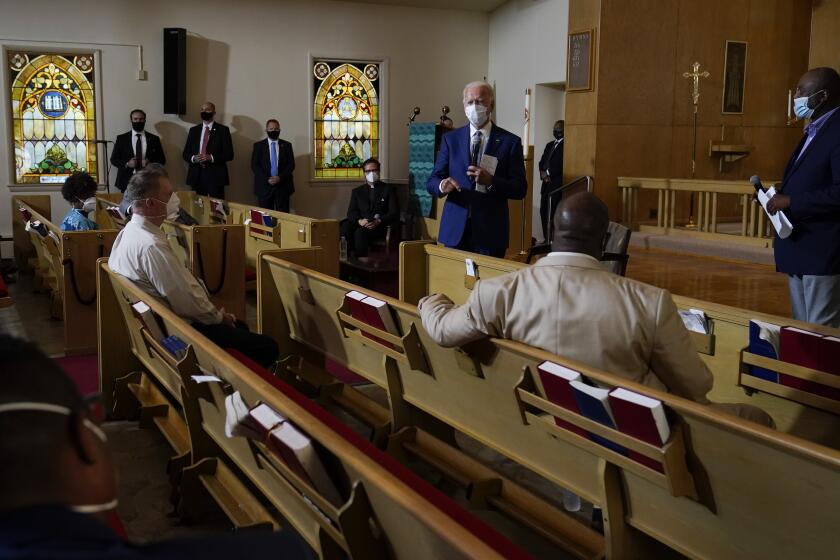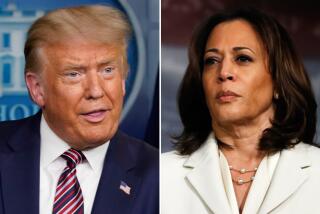A crazy 2020 makes for a presidential race like no other

- Share via
After months of stability, the presidential campaign enters the final sprint amid the greatest upheaval the country has faced in more than a generation: a teetering economy, a pandemic and divisions over racial discrimination and policing that have made November’s contest, both sides agree, the most consequential election many voters have ever seen.
The fundamentals of the contest have not changed, though the scheduled debates loom large. Democrat Joe Biden clings to a healthy lead over President Trump in national polls and a narrower advantage in most battleground states, as the two vie for an unusually small number of voters still up for grabs.
For the record:
1:03 p.m. Sept. 7, 2020An earlier version of this article said Donald Trump, at age 74, is the oldest president in U.S. history. Although Trump was the oldest American sworn in as president, Ronald Reagan was 77 when he left office. Also the article incorrectly said the date of the vice presidential debate is Oct. 2. The debate is scheduled for Oct. 7.
Much, however, remains unknown, including the messy mechanics of holding an election amid a widespread deadly disease, the trajectory of the country’s economic and health crises and, possibly, the result of covert interference like Russia’s meddling in the election four years ago.
Perhaps the biggest question as the contest hurtles into its post-Labor Day phase is the degree to which the election serves as a referendum on the incumbent — a perilous thing for a president who has never enjoyed majority support — and how successful Trump can be at recasting the race as a choice between himself and Biden as the alternative.
While the temptation may be to use 2016 as a guide, the political climate is vastly different.
Trump, for one, has been in office for three and a half years and has a record he must defend. Biden, though not as unpopular as Hillary Clinton, is weighted by his own baggage, not least his age — now 77, he would be the oldest person ever sworn in as president (a distinction currently held by Trump, who is 74).
“I figure there are only three things in common between 2016 and 2020,” said Charlie Cook, a nonpartisan political analyst who has spent decades handicapping elections. “Both are presidential races. Donald Trump is the Republican nominee both times. And both years begin with 20.”
U.S. officials tracking Russian disinformation operations say it clearly echoes the Trump campaign’s efforts to undermine Biden.
As always, the contest is not a national election but a series of discrete races that will be decided by the electoral college.
The focus now narrows to a set of battleground states that are crucial to the outcome. Republicans and Democrats agree that Wisconsin, Michigan and Pennsylvania — three states Trump barely won four years ago — are pivotal.
Also crucial will be Florida, a quadrennial swing state, and Arizona, a traditional Republican stronghold that has grown highly competitive. Surveys also suggest tight races in North Carolina, Georgia, Iowa and Ohio, all of which Trump carried in 2016.
Nearly all of the campaign is being waged on territory the president won, though Republicans have taken the offense by targeting Minnesota, a historically Democratic state that Clinton narrowly carried four years ago, and New Hampshire, which the president barely lost. Nevada, which voted Democratic the last several elections, is another state both sides are watching.
For most of his presidency, Trump oversaw a robust economy and, while it has tumbled into free fall amid the pandemic, those good times arguably remain his strongest asset. He maintains an edge, albeit a narrowing one, as the candidate voters most trust to bring about an economic recovery. That, Republican strategists say, can overcome any reservations voters may have about Trump’s brash personality and provocative personal conduct.
“People may not want to put a yard sign in their front yard, but they are rooting for someone that can get the economy moving again,” said Scott Reed, senior political strategist for the right-leaning U.S. Chamber of Commerce. “As we come out of this pandemic and the economy comes back, folks are going to be voting their pocketbook or purse. That’s why I’m thinking this will be a fight to the finish.”
Seeking to make the election a choice, rather than a straight-up referendum, Trump has leaned forcefully into a “law and order” theme, siding with police amid the continuing protests over racial inequities and spotlighting instances of property destruction during mostly peaceful rallies as the work of radicals aligned with Biden and his fellow Democrats.
Biden has fought back by redefining safety to encompass containment of the coronavirus, providing universal healthcare and cushioning the blows of a sagging economy.
Recent polls suggest he has gotten the better of the security argument, with most voters seeing the Democrat as more suited to handling protests, reducing violence and keeping Americans safe.
There is little sign that women — in particular, the key voting bloc of college-educated suburban women — have been swayed by Trump’s crime-fighting pitch. Those voters helped deliver control of the House to Democrats in the 2018 midterm election and remain soured on the president.
“He helped instigate what we’re seeing in terms of protest and uprising and says ‘I alone can fix it,’” said Margie Omero, a Democratic pollster, who has conducted extensive research among women voters. “There’s no evidence that people are seeing it that same way.”
Trump also trails among independent voters and self-described moderates, two other vital constituencies.
At the same time, some polls suggest that Trump is running stronger among Black and Latino voters than he did in 2016. Those groups are crucial to Biden’s prospects in November and are especially key in the battlegrounds of Florida, Arizona and the Upper Midwest.
Adrianne Shropshire, executive director of BlackPAC, a political action group focused on mobilizing Black voters, said Biden’s numbers appear headed in the right direction and expressed confidence that he would outperform Clinton’s 2016 showing, citing the compounded challenges of COVID-19, economic distress and the renewed focus on structural racism.
“They’re going to vote for Joe Biden, because he is a remedy of what ails folks right now,” Shropshire said.
Joe Biden visited the restive Wisconsin town on Thursday, two days after President Trump did, as their competing messages — racial justice versus ‘law and order’ — roil the presidential campaign.
Buoying Trump is his unshakable political base, constituting 40% to 45% of the electorate, which Republicans believe has room for considerable growth. They say the president has a vast number of staunch supporters who didn’t bother turning out in 2016. “The challenge for [Trump],” said Brad Todd, a GOP strategist, “is convincing them that voting matters.”
The pandemic has upended “get out the vote” efforts by both parties. Democrats, adhering to social distancing guidelines, have turned to phone calls, texts and virtual communications to rally their partisans. The Biden campaign said it had 2.6 million conversations with voters in August alone. The GOP has continued with a traditional program of door-knocking, and strategists take heart at the excitement they sense at the campaign’s ground level.
“It’s really not sexy work ... to go door-to-door, to make the phone calls, to hold the events,” said Rick Gorka, a spokesman for the Republican National Committee, who said the party is closing in on 100 million voter contacts this election cycle. “To do all that takes infrastructure and energy and enthusiasm, and we’re pulling them off on a daily basis across all our target states.”
Democrats are thrilled by Biden’s strong fundraising — the campaign netted a record-crushing $364.5 million in August — which has removed any concerns about running short of cash. Biden’s campaign is so flush that Priorities USA, a Democratic political action committee, has branched out to undertake an unprecedented voting education campaign.
“Priorities has actually for the first time in our history launched a mobilization program specifically focused on vote-by-mail ... to encourage people to request a ballot and actually walk them through how to do it,” said Guy Cecil, the group’s executive director.
Both sides agree that the three scheduled presidential debates, starting Sept. 29, will be critical. (Vice President Mike Pence will face Biden’s running mate, California Sen. Kamala Harris, in a single debate Oct. 7.)
The sessions offer Biden, in particular, the opportunity to address the major issue hanging over his candidacy. “Joe Biden has to answer a question for the voters, and that is, ‘Is he up for the job?’” said Peter Hart, a veteran Democratic pollster.
Apart from the debates, many Democrats say sabotage of the election is the thing that worries them most.
The U.S. Postal Service, guided by a major Trump donor, Postmaster General Louis DeJoy, has taken a number of steps that have caused widespread delays in mail delivery and raised concerns that mail-in voting — which many Democrats prefer — could be hampered ahead of the Nov. 3 election. Trump has also sought to undermine voter confidence in mail balloting, most recently by suggesting that his supporters vote twice to stress-test the system.
Even without those anxieties, Biden supporters would find reason to be nervous, said Bob Shrum, a longtime Democratic strategist who now directs USC’s Center for the Political Future.
“Democrats are neurotic,” he said. “Especially after what happened in 2016.”
Times staff writer Janet Hook in Washington contributed to this report.
More to Read
Get the L.A. Times Politics newsletter
Deeply reported insights into legislation, politics and policy from Sacramento, Washington and beyond. In your inbox three times per week.
You may occasionally receive promotional content from the Los Angeles Times.














